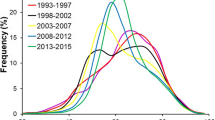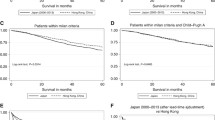Abstract
Purpose
California Cancer Registry data were used to explore the impact of hepatocellular carcinoma (HCC) surveillance on patient outcomes. The purpose of this analysis was to determine the trend in diagnosis of early-stage HCC in California from 1988 to 2010.
Methods
Patients 20+ years old, diagnosed with early HCC during 1988–2010 in California, were included. Stratified proportions of early HCC were evaluated to estimate any trends and significant disparities. The primary endpoint was the average annual percent change (AAPC) of the proportion of early-stage HCC; 2- and 5-year survival trends were calculated for age, sex, race, SES, and stage.
Results
A total of 13,855 patients were diagnosed with early HCC. The proportion of patients diagnosed early increased from 19.2 to 49.2 % between 1988 and 2010, at an AAPC of 4.3 %. The proportion of cases diagnosed with early HCC increased in all demographic groups. Both the 2- and 5-year cause-specific survival analyses showed that survival among HCC patients has been increasing since 1988.
Conclusion
The proportion of HCC cases diagnosed early, and the 2- and 5-year survival trends of all HCC patients have increased in California since 1988. It is not entirely clear whether better diagnostic imaging or better surveillance has led to these findings and whether earlier diagnosis has led to improved patient survival. This increase in survival among patients with HCC may be correlated with the innovation of new treatments and most importantly that patients are being diagnosed earlier to receive such treatments.
Similar content being viewed by others
References
Hepatocellular Carcinoma (Humana Press, 2010). http://link.springer.com/10.1007/978-1-60327-376-3
Naugler W, Schwartz J (2008) Hepatocellular carcinoma. Liver Dis 54:432–444
American Cancer Society. Liver Cancer (2015). http://www.cancer.org/cancer/livercancer/detailedguide/liver-cancer-what-is-liver-cancer
El-Serag HB (2011) Hepatocellular carcinoma. N Engl J Med 365:1118–1127
Rahib L et al (2014) Projecting cancer incidence and deaths to 2030: the unexpected burden of thyroid, liver, and pancreas cancers in the United States. Cancer Res. doi:10.1158/0008-5472.CAN-14-0155
Monsour HP Jr et al (2013) Hepatocellular carcinoma: the rising tide from east to west—a review of epidemiology, screening and tumor markers. Transl Cancer Res 2:492–506
Cook S et al (2014) Annual report on the status of cancer in California, 1988–2010. http://www.ccrcal.org/pdf/Reports/AnnualReport2014_9-15-14.pdf
Crissien AM, Frenette C (2014) Current management of hepatocellular carcinoma. Gastroenterol Hepatol 10:153–161
Altekruse SF, McGlynn KA, Reichman ME (2009) Hepatocellular carcinoma incidence, mortality, and survival trends in the United States from 1975 to 2005. J Clin Oncol 27:1485–1491
Shanghai Coordinating Group for Research on Liver Cancer (1979) Diagnosis and treatment of primary hepatocellular carcinoma in early stage: report of 134 cases. Chin Med J (Engl) 92:801–806
Yost K, Perkins C, Cohen R et al (2001) Socioeconomic status and breast cancer incidence in California for different race/ethnic groups. Cancer Causes Control CCC 12:703–711
Schwarz RE, Smith DD (2008) Trends in local therapy for hepatocellular carcinoma and survival outcomes in the US population. Am J Surg 195:829–836
Yang JD et al (2011) Factors that affect risk for hepatocellular carcinoma and effects of surveillance. Clin Gastroenterol Hepatol 9:617–623
El-Serag HB, Marrero JA, Rudolph L, Reddy KR (2008) Diagnosis and treatment of hepatocellular carcinoma. Gastroenterology 134:1752–1763
Song DS, Bae SH (2012) Changes of guidelines diagnosing hepatocellular carcinoma during the last ten-year period. Clin Mol Hepatol 18:258–267
Llovet JM, Bruix J (2000) Early diagnosis and treatment of hepatocellular carcinoma. Best Pract Res Clin Gastroenterol 14:991–1008
Artinyan A et al (2010) Race, ethnicity, and socioeconomic status influence the survival of patients with hepatocellular carcinoma in the United States. Cancer 116:1367–1377
Chen J-D et al (2010) Carriers of inactive hepatitis B virus are still at risk for hepatocellular carcinoma and liver-related death. Gastroenterology 138:1747–1754
Yuen M-F et al (2008) Independent risk factors and predictive score for the development of hepatocellular carcinoma in chronic hepatitis B. J Hepatol 50:80–88
Yu L, Sloane DA, Guo C et al (2006) Risk factors for primary hepatocellular carcinoma in Black and White Americans in 2000. Clin Gastroenterol Hepatol 4:355–360
Kao W-Y et al (2011) A comparison of prognosis between patients with hepatitis B and C virus-related hepatocellular carcinoma undergoing resection surgery. World J Surg 35:858–867
Nathan H et al (2012) National trends in surgical procedures for hepatocellular carcinoma: 1998–2008. Cancer 118:1838–1844
Acknowledgments
The collection of cancer incidence data used in this study was supported by the California Department of Public Health as part of the statewide cancer reporting program mandated by California Health and Safety Code Section 103885; the National Cancer Institute’s Surveillance, Epidemiology, and End Results Program under contract HHSN261201000140C awarded to the Cancer Prevention Institute of California, contract HHSN261201000035C awarded to the University of Southern California, and contract HHSN261201000034C awarded to the Public Health Institute; and the Centers for Disease Control and Prevention’s National Program of Cancer Registries, under agreement U58DP003862-01 awarded to the California Department of Public Health. The ideas and opinions expressed herein are those of the author(s) and endorsement by the State of California, Department of Public Health the National Cancer Institute, and the Centers for Disease Control and Prevention or their Contractors and Subcontractors is not intended nor should be inferred.
Funding
This work was supported by the NCI Comprehensive Cancer Center Support Grant (P30CA93373).
Author information
Authors and Affiliations
Corresponding author
Ethics declarations
Conflict of interest
The authors declare that they have no conflict of interest.
Rights and permissions
About this article
Cite this article
Rodriguez, D.N., Torruellas, C. & Cress, R.D. Trends in early-stage hepatocellular carcinoma, California 1988–2010. Cancer Causes Control 27, 325–331 (2016). https://doi.org/10.1007/s10552-015-0705-2
Received:
Accepted:
Published:
Issue Date:
DOI: https://doi.org/10.1007/s10552-015-0705-2




